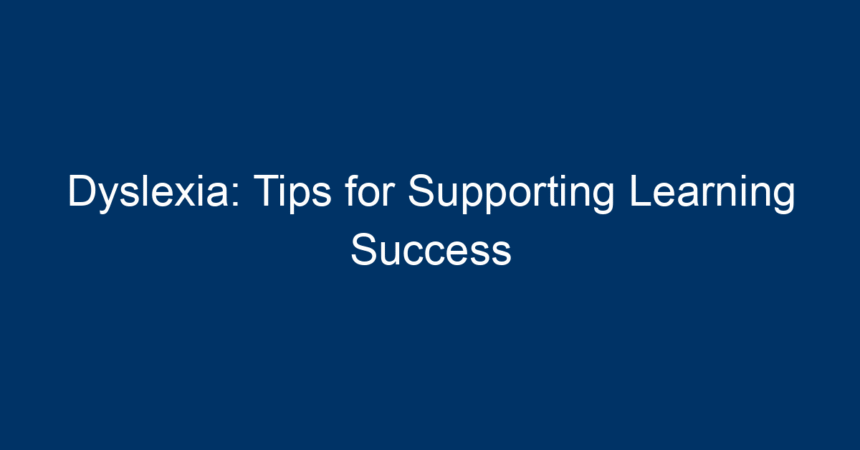Dyslexia is a common learning disability that affects the ability to read, write, and spell. This neurobiological condition is estimated to impact around 10% of the population, making it crucial for parents, educators, and peers to understand its implications. Supporting individuals with dyslexia requires a multi-faceted approach that promotes confidence, effective learning techniques, and an understanding environment. In this article, we’ll explore practical tips and strategies for fostering learning success in those with dyslexia.
Understanding Dyslexia: What You Need to Know
Characteristics of Dyslexia
Dyslexia isn’t just about struggling to read; it can manifest in various ways, including:
- Difficulty with phonological processing (the ability to recognize and manipulate sounds in words)
- Problems with decoding words
- Challenges in spelling and writing
- Issues with reading fluency and comprehension
Recognizing these symptoms is the first step towards providing effective support. Understanding that dyslexia can look different for each individual is also vital.
The Importance of Early Detection
Early identification of dyslexia significantly increases the chances of successful intervention. Parents and teachers should be attuned to signs of dyslexia in young children, such as:
- Late talking
- Difficulty learning nursery rhymes or recognizing letters
- Trouble with sequencing events
By seeking professional evaluations when signs are present, early interventions can be tailored to meet specific needs.
Creating a Supportive Learning Environment
Foster a Positive Atmosphere
Creating a nurturing environment is essential for individuals with dyslexia. Here are some strategies to encourage a positive learning experience:
- Encouragement Over Criticism: Celebrate achievements, no matter how small. This builds confidence and resilience.
- Encourage Independence: Allow learners to take charge of their learning process when possible. Scaffolding supports independence, enabling them to tackle challenges confidently.
Use Multi-sensory Approaches
Research shows that multi-sensory teaching methods can significantly enhance learning for individuals with dyslexia. Here’s how to implement these techniques:
- Visual aids: Incorporate pictures, diagrams, and color-coding to reinforce concepts.
- Auditory methods: Use read-aloud sessions or audiobooks to help with comprehension.
- Kinesthetic activities: Engage students with hands-on activities and games that promote learning through movement.
Provide Structured Learning Experiences
Offering clear, structured lessons can help learners with dyslexia feel more secure. Consider the following:
- Break lessons into smaller chunks: This makes the material more manageable.
- Use explicit instruction: Clearly define objectives and steps, and check for understanding regularly.
Tailored Learning Strategies for Dyslexia
Reading Strategies
Reading is often the biggest challenge for individuals with dyslexia. Employing specific strategies can enhance fluency and comprehension:
- Phonics Instruction: Focus on systematic phonics programs that teach the relationship between letters and sounds.
- Repetition: Encourage repeated reading of texts to build confidence and fluency.
- Use of Technology: Leverage technology, such as text-to-speech software and reading apps, to assist in learning.
Writing Techniques
Writing can be daunting for individuals with dyslexia. Here are strategies to make the writing process smoother:
- Graphic Organizers: Help organize thoughts visually before writing. This can simplify complex writing tasks.
- Word Prediction Software: This can ease the writing process by predicting words as they type.
- Dictation Tools: Encourage the use of speech-to-text technology to allow learners to express their thoughts without being hindered by writing difficulties.
Social and Emotional Support for Learners with Dyslexia
Building Self-Esteem
One of the most challenging aspects of dyslexia can be the emotional toll it can take on a learner. Here’s how to support their emotional wellbeing:
- Celebrate Strengths: Help them identify and build on their strengths in subjects or activities they excel in.
- Normalize the Struggle: Share stories of successful individuals with dyslexia to instill hope and resilience.
Encouraging Peer Interaction
Positive social interactions can boost self-esteem and create a sense of belonging. Consider these tips:
- Group Activities: Encourage participation in team-based activities where they can thrive in collaboration.
- Peer Support: Create opportunities for learners to tutor or support one another; this can foster a sense of community and shared experience.
Involving Parents and Teachers
Collaboration is Key
Parents and teachers should work together to create consistent strategies and expectations. This teamwork enhances the learning experience and provides a comprehensive support system. Here are actionable steps:
- Regular Communication: Establish a routine for updating each other on progress, challenges, and effective strategies.
- Professional Development: Educators should pursue professional development opportunities focused on dyslexia to implement best practices in the classroom.
Advocate for Appropriate Accommodations
Understanding and advocating for accommodations is crucial. These may include:
- Extended time for tests and assignments
- Access to audiobooks and technology
- Alternative assessment methods (such as oral presentations instead of written tests)
Resources for Parents and Educators
A wealth of resources is available to aid parents and educators in understanding and supporting learners with dyslexia. Some valuable resources include:
- International Dyslexia Association: Offers information and guidance on dyslexia.
- Reading Rockets: Provides strategies to promote reading success.
- Local support groups: Connecting with local organizations can provide community support and networking opportunities.
Actionable Insights for Learning Success
For those looking to support learners with dyslexia, here’s a concise list of actionable insights:
- Recognize Dyslexia: Understand the characteristics and symptoms to provide effective support.
- Create a Supportive Environment: Foster a positive, encouraging atmosphere for learning.
- Utilize Multi-sensory Learning: Incorporate different teaching methods to cater to various learning styles.
- Implement Tailored Strategies: Use specific reading and writing strategies to enhance learning.
- Emphasize Emotional Support: Focus on building self-esteem and encouraging peer interactions.
- Collaborate with Educators: Foster teamwork between parents and teachers for cohesive support.
- Seek Resources: Utilize tools and resources available to enhance the learning experience.
Conclusion
Supporting individuals with dyslexia is a journey that requires empathy, understanding, and strategic approaches. By implementing the tips outlined in this article, we can create an inclusive and supportive learning environment that empowers those with dyslexia to thrive. Remember, every learner is unique; patience and persistence will yield the best results. Together, we can pave the way for success for individuals with dyslexia, enabling them to reach their full potential.




